Hisense U8NQ is an example of a television that shows the brand is not planning to stay in the shadow of the competition. Thanks to MiniLED technology, it has achieved a truly high level of contrast and deep blacks. This is particularly evident in films – dark scenes look vivid, and bright elements in HDR stand out with intensity. Interestingly, the television supports many formats, including the most popular one – Dolby Vision, which highlights details that might be missed on other screens. Of course, there are times when in more demanding scenes, the details of smaller elements can be a bit weaker in representation, but the overall picture is very good. During everyday use, Hisense U8NQ is quite a comfortable and versatile television. A definite plus is the ability to record programmes and support for AirPlay. The remote is classic, simple, but very intuitive to use. Regarding the VIDAA operating system – it works quickly and without significant delays; however, we won’t find all applications here, such as Spotify or Tidal. If someone uses these platforms daily, the absence may be noticeable, although for many it will not be a crucial problem. As for motion on the screen, the U8NQ performs well. The 144 Hz panel and VRR and ALLM features ensure that the television handles smoothly both in dynamic films and during gaming. The gameplay was enjoyable, and the low input lag and stable image allowed for the enjoyment of every detail – even in fast, intense games. Hisense U8NQ is a television that proves it can compete with Korean manufacturers shoulder to shoulder. It offers really solid picture quality and practical features – of course, despite a few minor shortcomings. In its price category, it performs excellently and can be a good choice for both film enthusiasts and gamers.
- Matching (Score)
- Our verdict
- TV appearance
- Where to buy
- Contrast and black detail
- HDR effect quality
- Factory color reproduction
- Color reproduction after calibration
- Smoothness of tonal transitions
- Image scaling and smoothness of tonal transitions
- Blur and motion smoothness
- Console compatibility and gaming features
- Input lag
- Compatibility with PC
- Viewing angles
- TV efficiency during daytime
- Details about the matrix
- TV features
- Apps
- Playing files from USB
- Sound
Hisense U8NQ vs Hisense U7Q PRO
Direct compare
U8NQ
U7Q PRO / U78Q PRO


Panel type: LCD VA
Resolution: 3840x2160
System: VIDAA
Model year: 2024
Complete the survey to find out the result

Panel type: LCD VA
Resolution: 3840x2160
System: VIDAA
Model year: 2025
Complete the survey to find out the result

Overall rating
7.7
7.4
Movies and series in UHD quality
7.4
7.2
Classic TV, YouTube
7.0
7.1
Sports broadcasts (TV and apps)
6.9
6.7
Gaming on console
8.5
8.3
TV as a computer monitor
8.0
8.2
Watching in bright light
8.7
6.2
Utility functions
8.5
9.4
Apps
7.7
7.7
Sound quality
7.0
7.8
Complete the survey to find out what fits your preferences
Advantages
High contrast - miniLED backlighting
Excellent brightness - ideal for daytime use
Great for gamers - 144Hz, VRR, ALLM
Low input lag
Very good built-in speakers
Excellent contrast and black levels - true Mini-LED backlighting with a VA panel (65")
Very good motion smoothness - 4K@165 Hz panel
Very high HDR brightness - even above 1500 nits
Ideal for gaming - Low input lag, VRR, ALLM, 4x HDMI 2.1, 288Hz at 1080p.
The Vidaa operating system has many features such as Airplay, USB recording
Outstanding quality of tonal transitions
Disadvantages
The VIDAA operating system has certain shortcomings in music applications such as Spotify and Tidal
It has issues with font visibility on PC
No support for HGiG
Average viewing angles
Missing apps on the VIDAA platform
Our verdict
The U7Q PRO is a television that, after just a few minutes, sends a clear signal: "speed matters here." Hisense surprised us with how much has been packed into a device that doesn't cost a fortune. A refresh rate of 165 Hz in 4K, and even 288 Hz in Full HD – until recently, such numbers were reserved exclusively for top-tier gaming monitors. And here we have a mid-range television with almost a complete set of features for gamers, confidently throwing down the gauntlet to much pricier competitors. However, it doesn't stop at speed-related attributes. The U7Q PRO also boasts a very bright screen, reaching up to 1500 nits at its peak. Like every Mini-LED, it has its typical "quirks" associated with this technology, sometimes slightly exaggerating the image, but the overall visual effect remains very positive – especially in HDR content. It's also worth mentioning the Vidaa operating system – fast, intuitive, and equipped with features such as AirPlay, a voice assistant, and a web browser. While we won't find the full range of applications known from Android, the system performs really well in everyday use. So why is it "almost" ideal for gamers? The only missing feature is HGiG, which allows for precise adjustments of brightness levels in HDR games. This is a minor flaw, but it may be significant for console purists. Nevertheless, the U7Q PRO remains a very solid proposition – and a testament that Chinese manufacturers have not only caught up with their competition from Korea and Japan but in some aspects have even begun to surpass it.
TV appearance






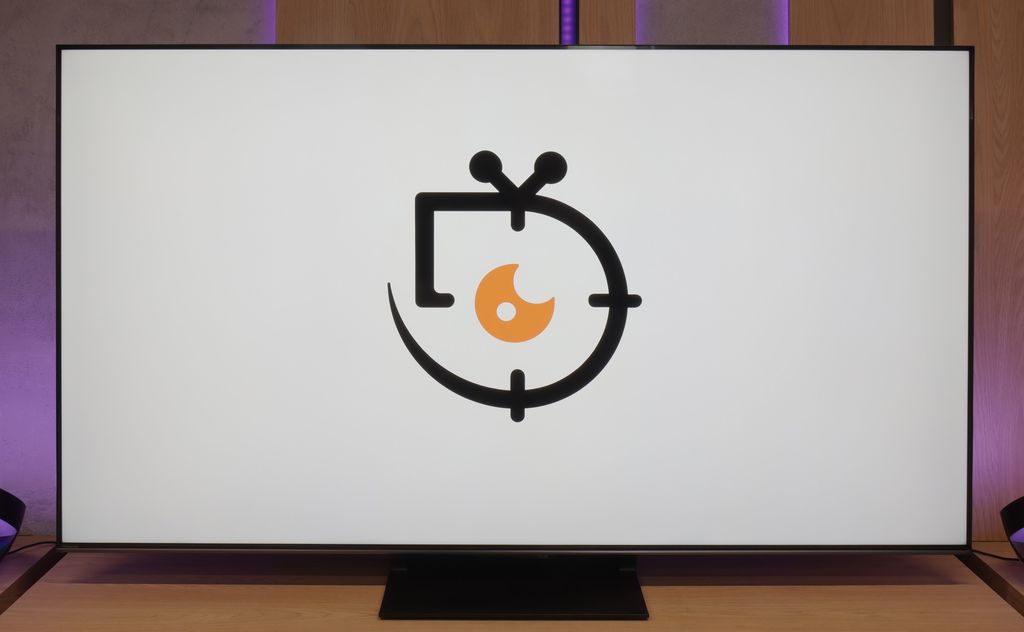
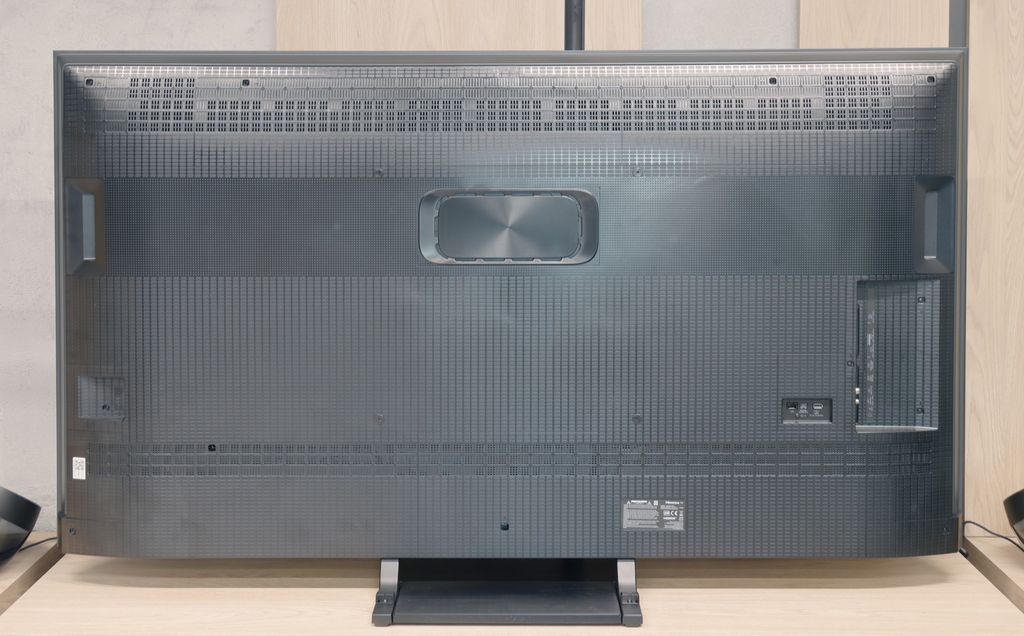
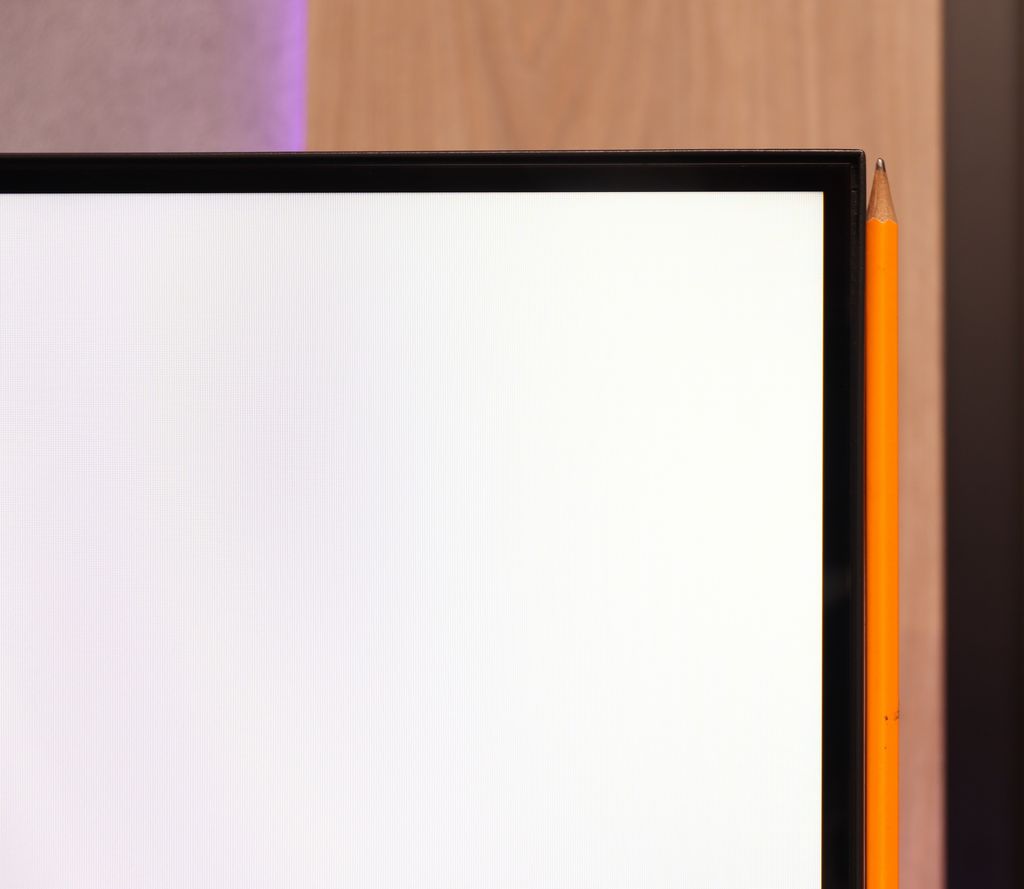

Contrast and black detail
8.4/10
8/10
Local dimming function: Yes, number of zones: 1600 (40 x 40)
Local dimming function: Yes, number of zones: 560 (20 x 28)
Contrast:

Result
244,000:1

Result
85,000:1

Result
40,500:1

Result
21,850:1

Result
15,350:1

Result
340,000:1

Result
62,850:1

Result
42,000:1

Result
11,100:1

Result
7,500:1
Halo effect and black detail visibility:

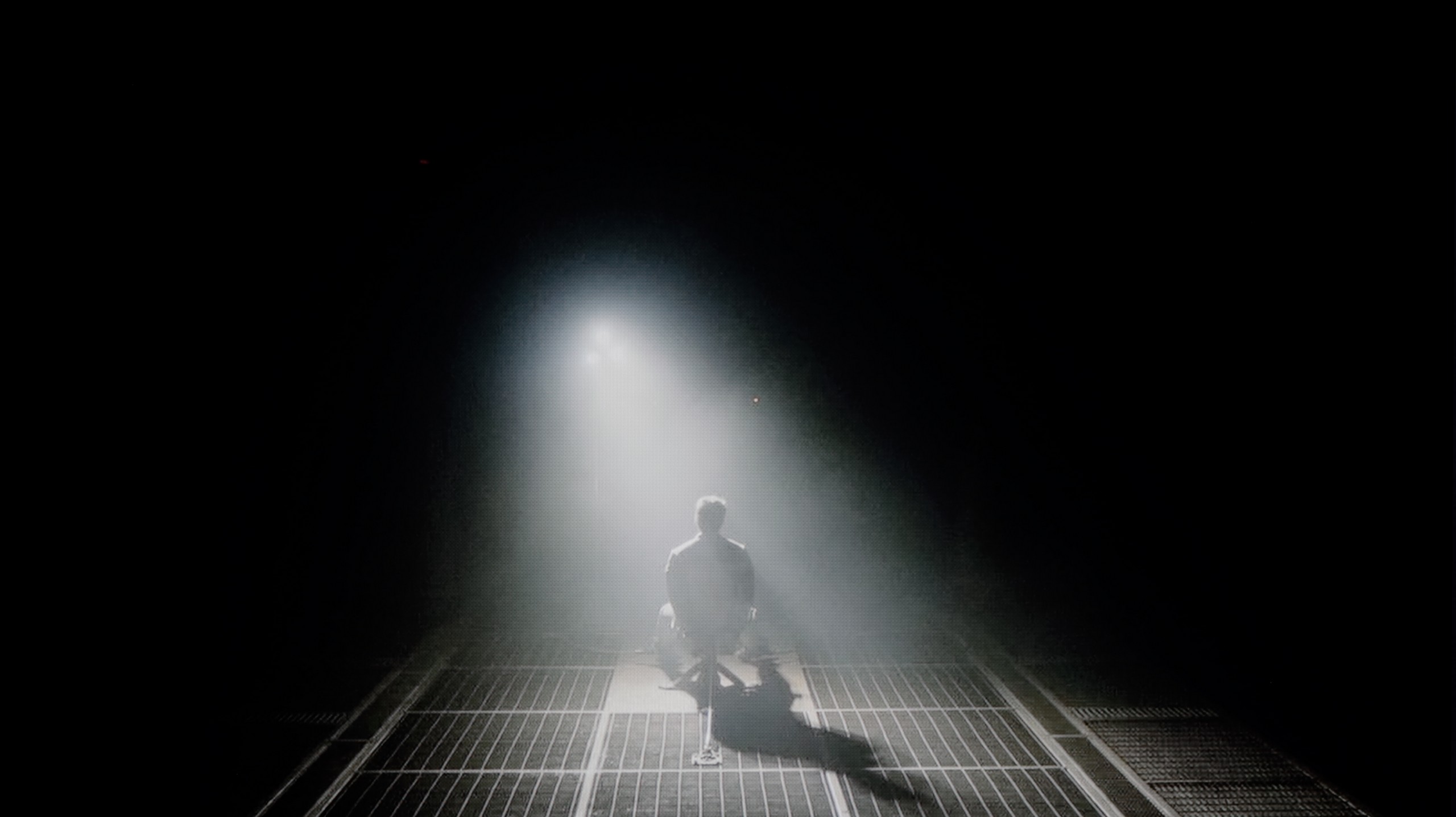
Hisense U8NQ is a television with a VA panel and advanced Mini LED backlighting. The 65-inch version has as many as 1600 local dimming zones, significantly improving picture quality, particularly in terms of brightness and contrast management. Larger sizes of the television have more zones, naturally enhancing contrast. The Hisense U8NQ achieves a contrast ratio of as much as 250,000:1, allowing for deep blacks and clear details in both bright and dark areas of the image. Thanks to Mini LED technology, the television effectively controls brightness, making details in darker scenes more visible.
Sometimes in more demanding shots, where small bright elements appear against a dark background, a halo effect may occur — a slight glow around objects. This effect can be noticed, for example, in the film "Sicario 2," where the halos around small lights can be somewhat bothersome. It may also happen that elements may appear muted but at the cost of better blacks - a visible effect in a test scene from the Pioneer Kuro disc. Despite these minor drawbacks, the use of Mini LED ensures that the Hisense U8NQ offers very good picture quality. The television performs excellently for watching movies in a dark room — the black is truly deep, and the contrast is clear, allowing viewers to fully enjoy details even in the darkest scenes.
Hisense U7Q PRO is a mini-LED television with a VA panel and – in the 65-inch version we tested – 560 local dimming zones. It's worth noting from the outset that this number varies depending on the size – larger screens will have more zones, while smaller ones will have fewer accordingly. However, regardless of this, the dimming system works really well here.
The contrast performs exceptionally well for the price range in which this model sits. In optimal conditions, the U7Q PRO can achieve results close to six-figure values, which not long ago was reserved for equipment at a much higher level. In practice – in scenes like the one from the film Oblivion – the image looks stunning. With slightly dimmed light in the room, it can be difficult at first glance to distinguish this television from organic screens. Of course, it is still an LCD with local dimming, so compromises are unavoidable. In more demanding scenes, where there are many small light sources, the U7Q PRO tends to dim too aggressively. Instead of a slight deterioration in black levels – some details that should be visible disappear. This is a side effect of the algorithm that strongly adheres to the rule of "black should be black," even at the cost of subtle image elements.
But nevertheless – contrast is one of the stronger points of this model.
HDR effect quality
6.6/10
6/10
Luminance measurements in HDR:

Result
1630 nit

Result
359 nit

Result
932 nit

Result
249 nit

Result
1331 nit

Result
1129 nit

Result
323 nit

Result
721 nit

Result
267 nit

Result
736 nit
Scene from the movie “Pan” (about 2800 nits)

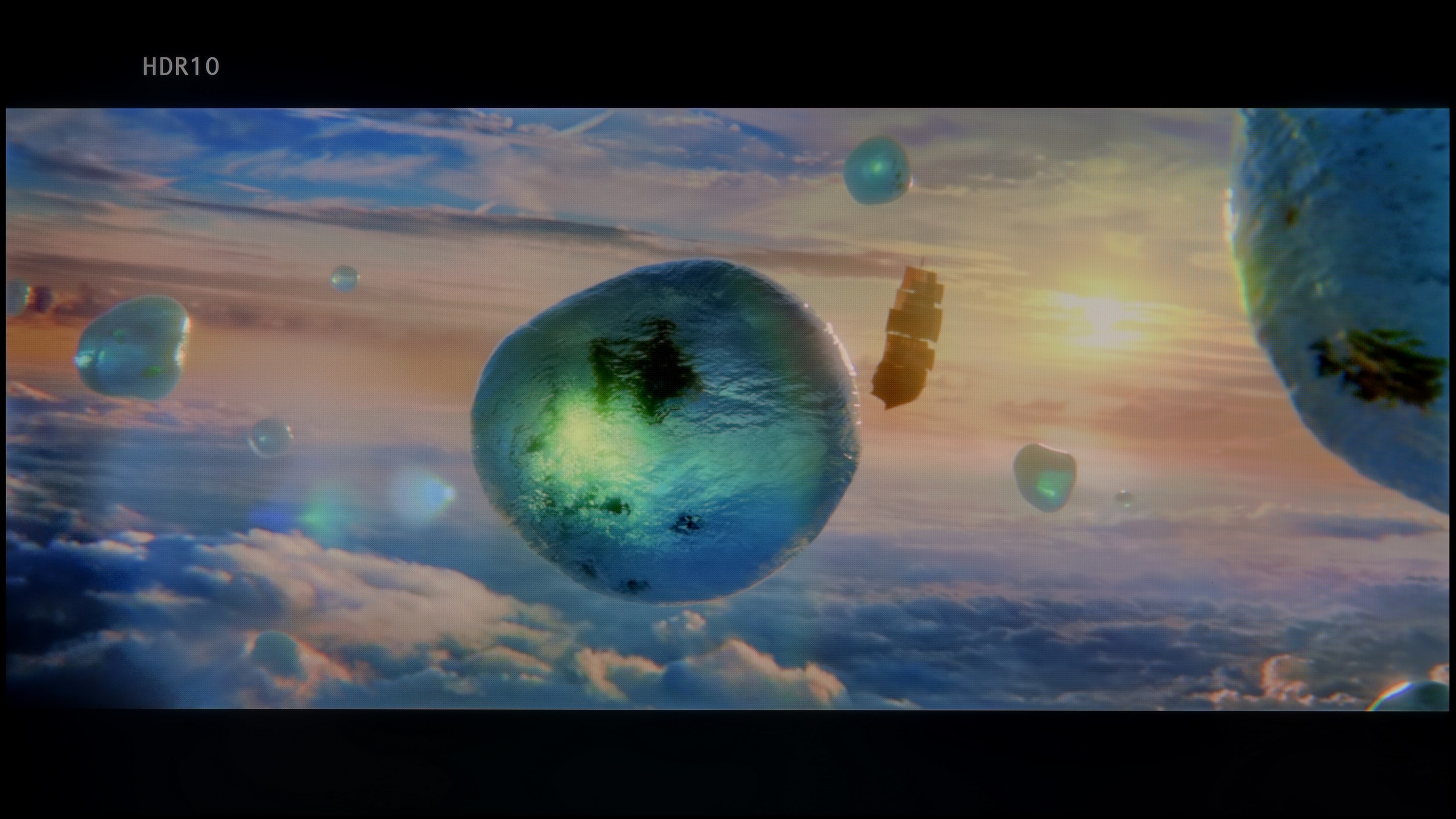
Scene from the movie “Billy Lynn” (about 1100 nits)


Static HDR10


Dynamic: Dolby Vision
Dynamic: Dolby Vision


HDR luminance chart:
Hisense U7Q PRO
Luminancja HDR
Luminance of RGB colors
Hisense U8NQ
Luminancja HDR
Luminance of RGB colors
Hisense U8NQ demonstrates its capabilities in terms of HDR, achieving a luminance chart score exceeding 2000 nits. In the first, third, and fifth scenes where the screen is bathed in light, the television displayed very high brightness that impresses and allows one to fully enjoy the HDR effect. Unfortunately, in the second and fourth scenes, such as those from the film "Sicario 2", the television encounters difficulties in maintaining brightness, resulting in disappointing scores around 250 nits. Although the large number of dimming zones should theoretically help, the algorithm responsible for their control does not always work perfectly — bright, small elements like the moon or helicopter lights are too dim, which detracts from the typical HDR effect. Instead of dazzling brightness, we get a more subdued light that does not realise the full potential of HDR. Nevertheless, the television deserves praise for its very good coverage of the DCI-P3 colour gamut at 97%. This results in vibrant colours, and most film scenes look really good, significantly enhancing the viewing quality.
U7Q PRO is truly a bright television. In synthetic tests, it achieved over 1500 nits, which is an outstanding result for this price range. Such brightness – at least in theory – allows for HDR content to be displayed as intended by the creators, even in more demanding scenes with strong lighting. In practice, it is often very good, but not always perfect. In bright scenes with large areas – like the test chart with intense sunlight from the movie "Pan" – the U7Q PRO makes a huge impression. It can almost dazzle with its brightness, which is definitely an advantage in the context of HDR content. Unfortunately, it doesn't always manage to maintain this when many small bright details appear on a dark background. In such moments, the local dimming algorithms choose to dim some bright elements to maintain good black levels – and the side effect is that some details simply disappear from the frame. This is a classic compromise in mini-LED televisions – and the U7Q PRO is no exception. However, with such a large number of dimming zones, one could have hoped for a slightly more mature algorithm responsible for their control. Fortunately, the overall perception of HDR content is decidedly positive. The U7Q PRO is not only bright but also colourful, thanks to the PFS LED (QLED) coating, the coverage of the DCI-P3 colour palette is at 95%, while BT.2020 is around 73%.
Factory color reproduction
5.1/10
6.2/10


Factory Mode
After calibration


Factory Mode
After calibration
The Filmmaker mode on the Hisense U8NQ television can be described as the most accurate mode available on this model. Despite its accuracy, it has significant errors in reproducing reference images, which we will now describe. In the case of HD content, the white balance shows a clear dominance of red, making the image overly pink and warm. The comparative photo below illustrates how this effect impacts content presentation. The brightness characteristics also leave much to be desired — too low a gamma results in an excessively bright screen, and blacks appear elevated, making the overall image seem cooler than it should be.
In the case of 4K HDR content, the problem is the opposite — the white balance shows too great a dominance of blue, resulting in an artificial appearance and an unnaturally sharp image. All of these deviations for both HD and 4K HDR content can be confirmed using the Colour Checker test, which clearly demonstrates how colours deviate from correct standards.
We tested the U7Q PRO in the best possible picture mode offered by this model – Filmmaker Mode. And indeed, this mode performs the best in terms of colour reproduction. However, that doesn't mean it's perfect. In our test unit, both in SDR and HDR content, the image had a slightly cooler tone. The white balance was skewed towards blue, giving the overall impression of being a bit "colder". It may not be glaring, but it is definitely noticeable – especially on white backgrounds, which seemed slightly bluish rather than neutral. Additionally – as we mentioned earlier – the television has a tendency to slightly brighten and oversaturate the image, which is also confirmed by the gamma and EOTF graphs. All this together means that without calibration, the image can appear somewhat unnatural – too cool, with slightly exaggerated dynamics. Therefore, we decided to carry out our own calibration – and you can see its effects and graphs below.
Color reproduction after calibration
7.4/10
7.5/10

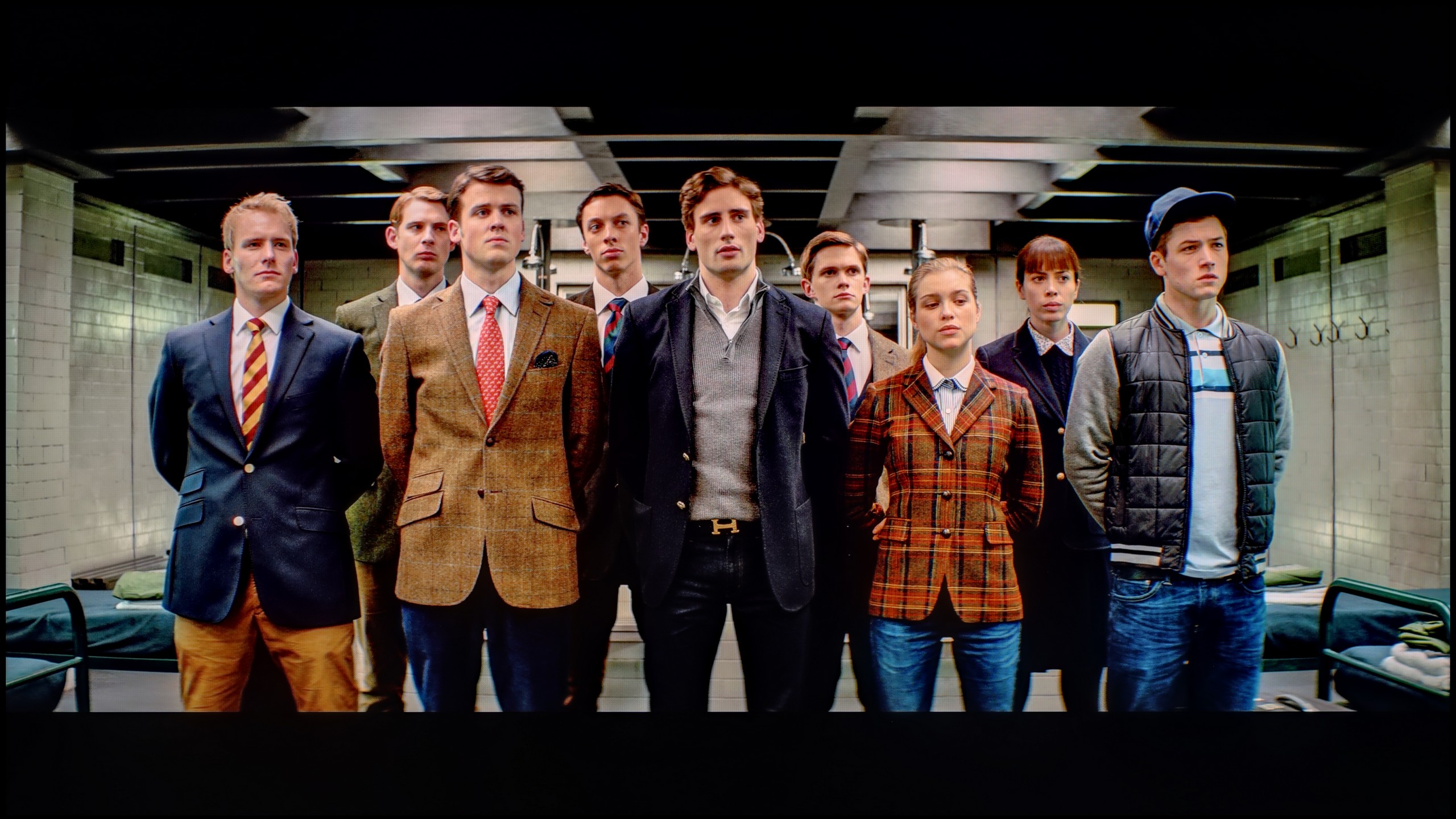


The white balance for both 4K and HD content has been significantly adjusted, which has greatly improved the picture quality. Although some errors are still visible, they are not large enough to heavily affect the perception of the image. A significant improvement can also be noticed in the gamma brightness characteristic — the picture is no longer excessively bright, translating into more natural blacks and better contrast.
However, as with many other Hisense models, there are visible issues with the EOTF curve, which is responsible for managing brightness in high-quality materials. Although at first glance it may seem correct, when the filter is applied to the "EOTF in films" chart, it is evident that the television somewhat "manipulates" 4K content. It is clear that the EOTF curve is significantly below the reference level, leading to an overall dimming of the image compared to the reference. We noticed this effect in previously tested scenes from the films "Pan" and "Billy Lynn." While it is not a serious issue, it is worth noting. It may be of great importance to those seeking a display with the most faithful reproduction of the image. Despite this error, for most, the picture will be more enjoyable. Colours are better represented, and the overall picture quality is significantly improved.
Thanks to the calibration, we managed to tame the white balance in SDR and HDR content. In the case of SDR materials, the effect is really very good – the image becomes neutral, cohesive, and simply pleasant to take in. Everything looks as it should.
HDR performs a bit worse. Although the white balance appears correct and the image overall gains in naturalness, unfortunately, the delta E errors remain noticeable. Why? Because Hisense does not give us full control over how the television manages brightness in HDR mode with the U7Q PRO model. This is where the limitation comes into play. When we look at the EOTF curve for HDR content, we can clearly see what we mentioned earlier – at the beginning of the graph, there is a distinct drop, meaning the television darkens the smallest areas more than it should. On the other hand – the brightest elements can sometimes be overly bright. As a result, some details get lost, others are too aggressive, and overall control over brightness does not always match what we are trying to achieve during calibration.
Does the image look better after calibration? Definitely yes, in terms of colour. But when it comes to managing brightness in HDR, we have to accept that the Hisense U7Q PRO will do it in its own way.
Smoothness of tonal transitions
9.1/10
9.5/10







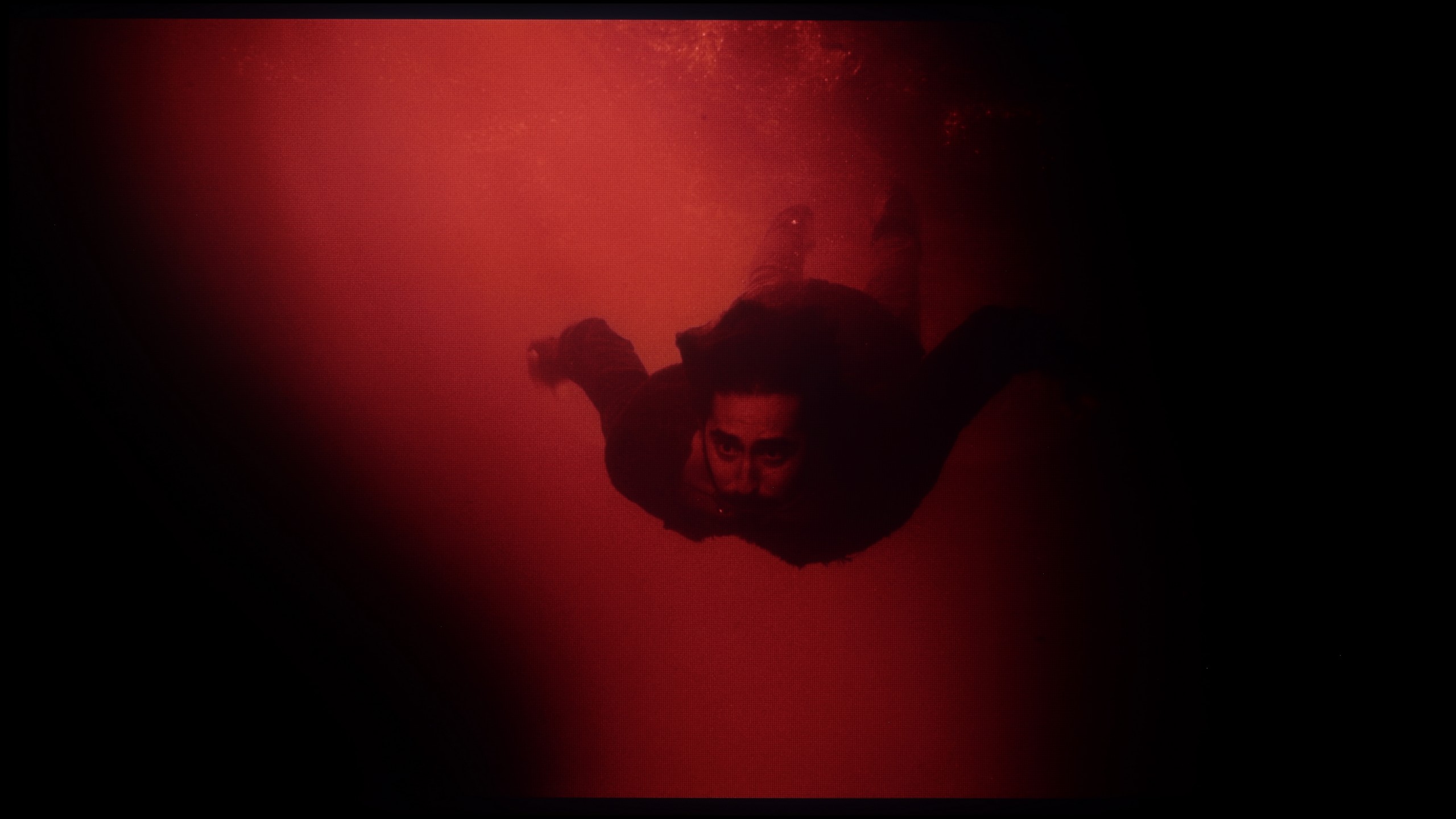




Hisense U8NQ offers excellent smoothness of tonal transitions. The image is very well balanced, and the transitions between different shades of colour are almost flawless. For more discerning viewers, slight banding can be noticed in darker hues; however, these imperfections are minimal and do not significantly affect the overall picture quality. The tonal smoothness is at a very high level, making watching content on this television exceptionally enjoyable, without noticeable issues with gradients and colour transitions.
The U7Q PRO handles tonal transitions really well. Colours blend smoothly, without any banding, stripes or strange artefacts. Even in more challenging scenes that typically expose any imperfections – there was nothing to criticise here. The image simply looks clean. Gradients – both coloured and grey – are smooth, nothing tears, nothing distracts. This is one of those elements that you don’t pay attention to while watching… certainly not in the case of the U7Q PRO.
Image scaling and smoothness of tonal transitions
5.5/10
7/10
Smooth transition function

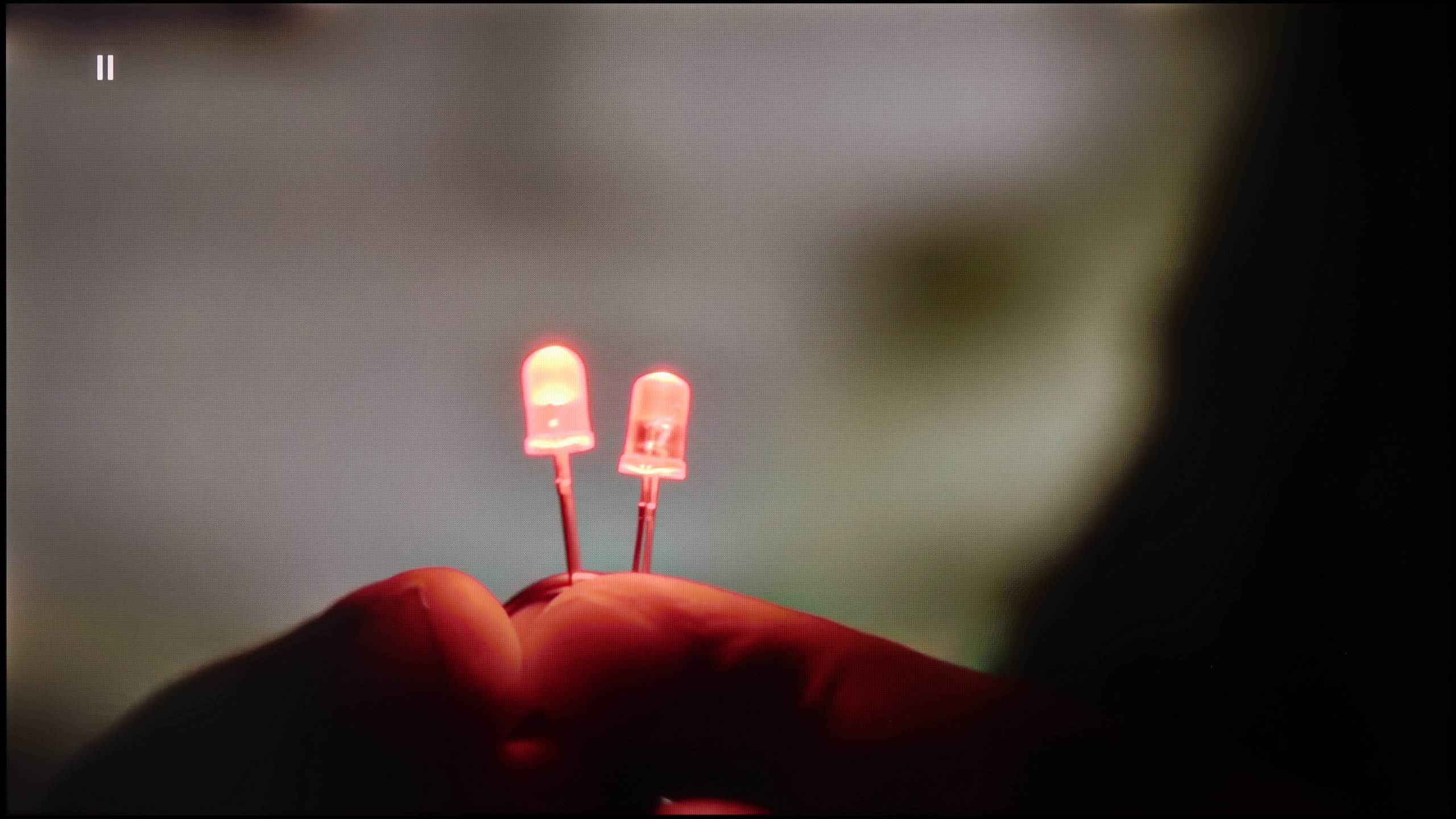
Image without overscan on the SD signal


In the context of smoothing tonal transitions, the television Hisense U8NQ unfortunately struggles. The “Smooth and Gradient Picture” function does not yield noticeable effects — there is no improvement in any setting, which is disappointing, especially for demanding scenes with a lot of subtle tonal transitions.
Regarding digital processing, or so-called upscaling, the scene with the model is presented correctly — her outline is clear, without significant cropping. Similarly, thin lines, such as tree branches, exhibit slight jaggedness, but overall it looks plastic and soft, which creates a good impression. Unfortunately, there is also an issue with so-called overscan, which causes cropping of the image at the edges. This can be frustrating when watching content like news, where lower information bars may be partially invisible.
If someone happens to come across older materials where the colour banding issue occurs – Hisense has a solution for that. In the U7Q PRO, we find a function called "Smooth and Gradient Image". Set to the "Medium" level, it works really well – removing most issues with gradation while not smoothing out the entire image, like blurring in Photoshop. 😉 Film grain remains, details do not disappear – this is exactly how it should work. Well done on the implementation!
As for upscaling weaker materials, it is simply good. It is not at the level of the most expensive televisions with advanced upscaling, but older content looks good. There is minor aliasing at very low resolutions, but this is completely normal and hard to avoid. On the plus side – even with the oldest materials, there is no overscan effect, the image is neither cropped nor artificially stretched.
Blur and motion smoothness
8.4/10
7.5/10

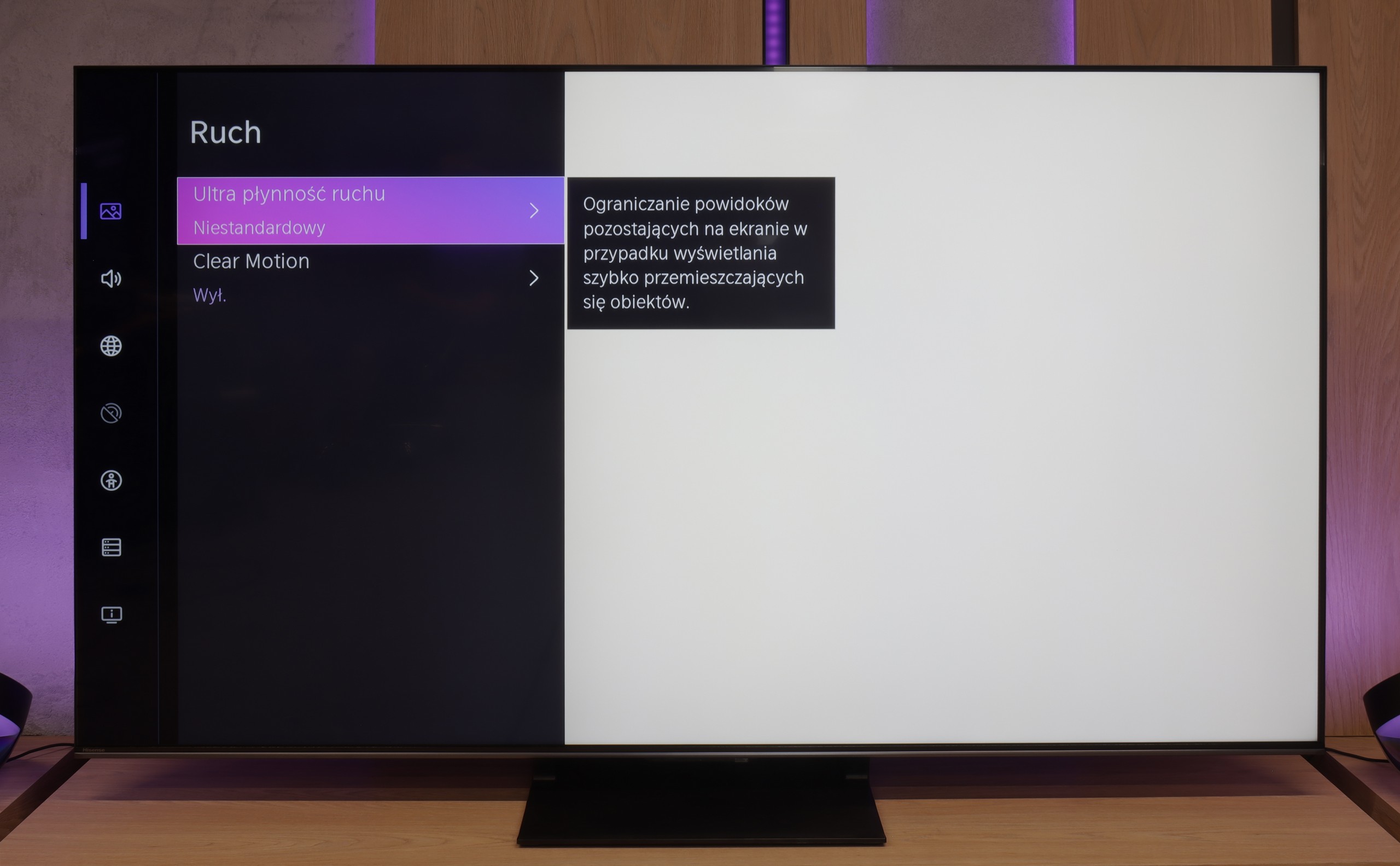
Blur (native resolution, maximum refresh rate):



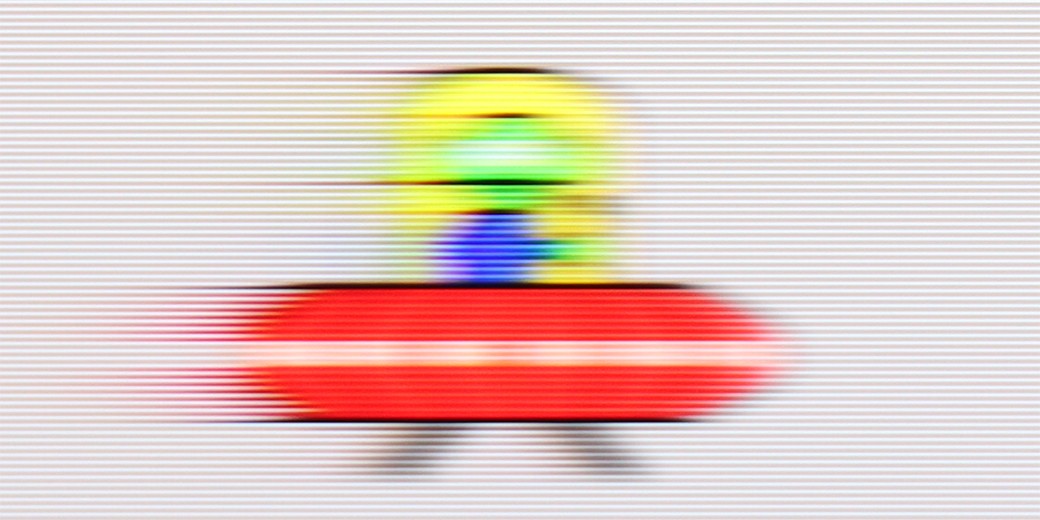
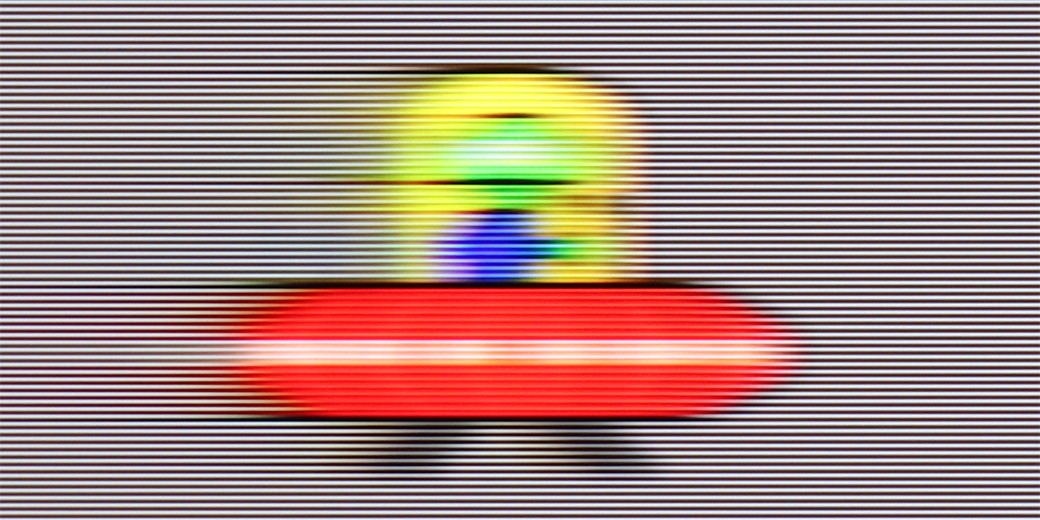
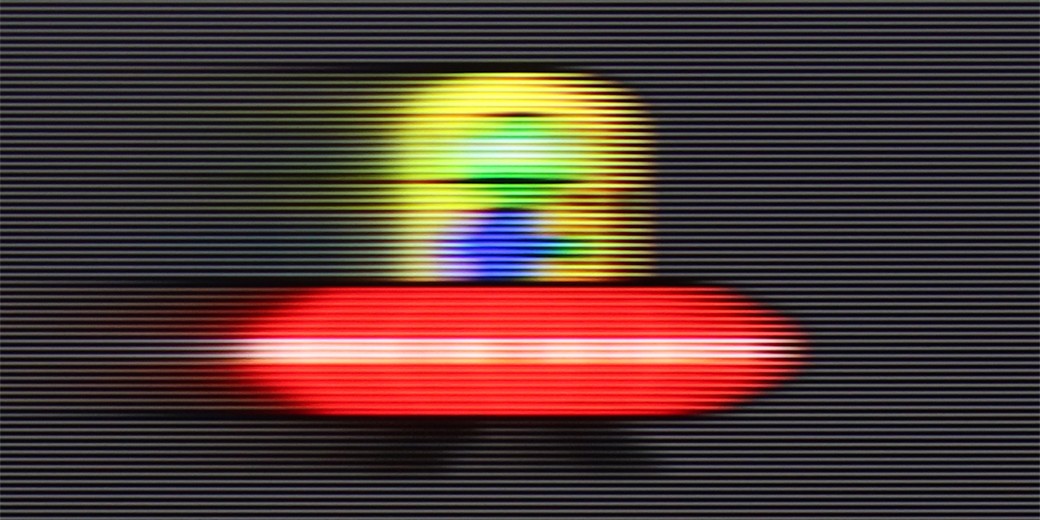
Blur (BFI function enabled):






Smużenie ():
Smużenie (1080p 288Hz):



Hisense U8NQ is equipped with a 144 Hz panel, making it an excellent choice for both sports and gaming. The television will also easily satisfy film enthusiasts, as it features a built-in "Ultra Motion Smoothness" processor that allows you to control the smoothness of the image — you can decide whether you prefer a more "framey" picture or a smoother, theatrical effect. This provides great flexibility in adjusting motion quality to the viewer’s individual preferences.
“Speed” – this word came up most often during our tests of the U7Q PRO. The television is equipped with a 165 Hz panel, which is impressive in itself – especially since we are talking about a model in the mid-range price category. Of course, PC gamers will benefit the most from its full capabilities, but even with everyday viewing, it's clear that this is a fast and efficient panel. Like most modern televisions, the U7Q PRO can also enhance the fluidity of films that were originally recorded at 24 frames. In the menu, we find a slider that allows us to adjust the effect to our own preferences – from a more cinematic look, with subtle motion, to stronger smoothing with the characteristic “telenovela effect.”
Console compatibility and gaming features
8.5/10
8.5/10
- ALLM
- VRR
- VRR range48 - 144Hz48 - 288Hz
- Dolby Vision Game Mode
- Correct implementation of HGIG
- 1080p@120Hz
- 1440p@120Hz
- 4K@120Hz
- Game bar

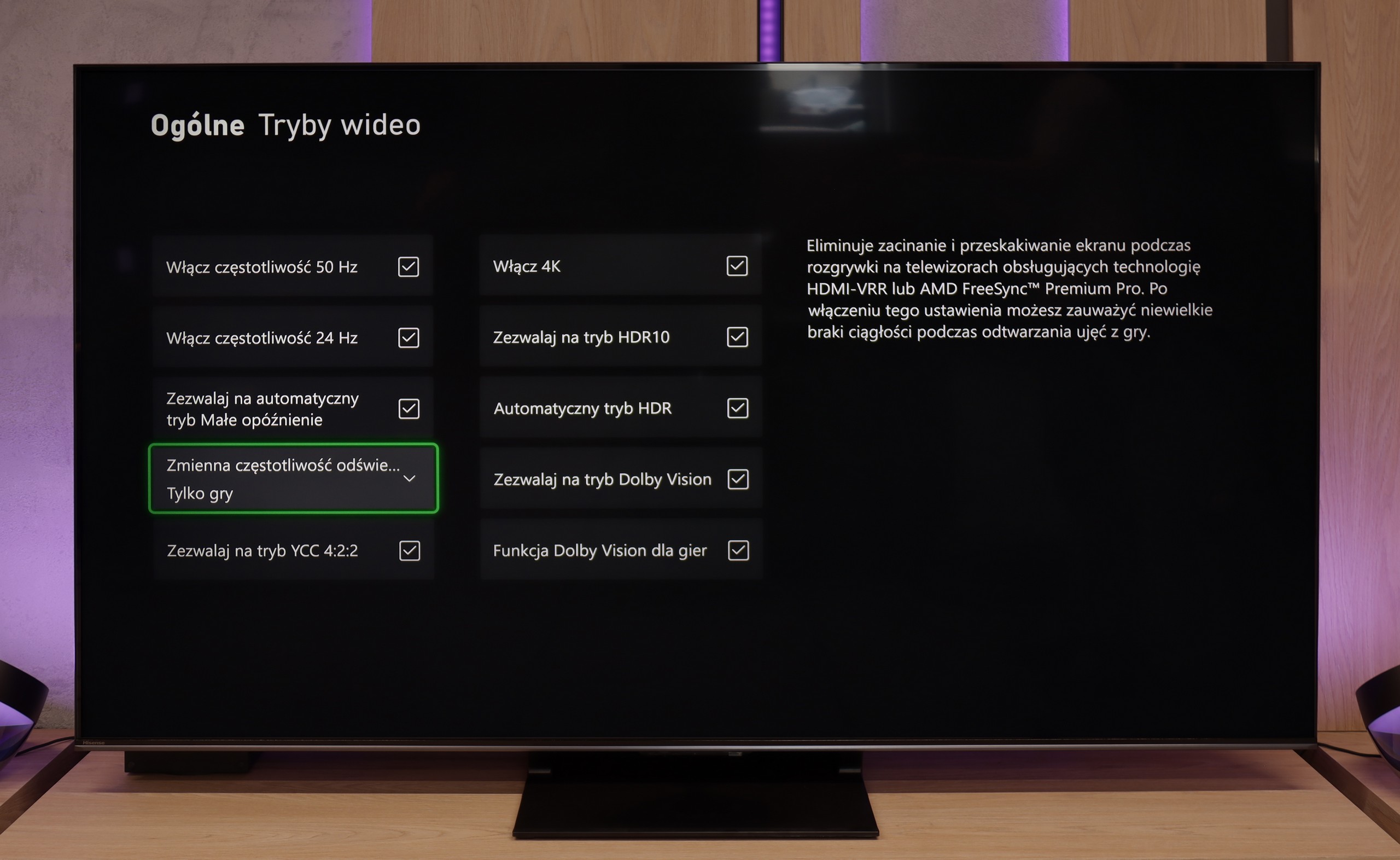



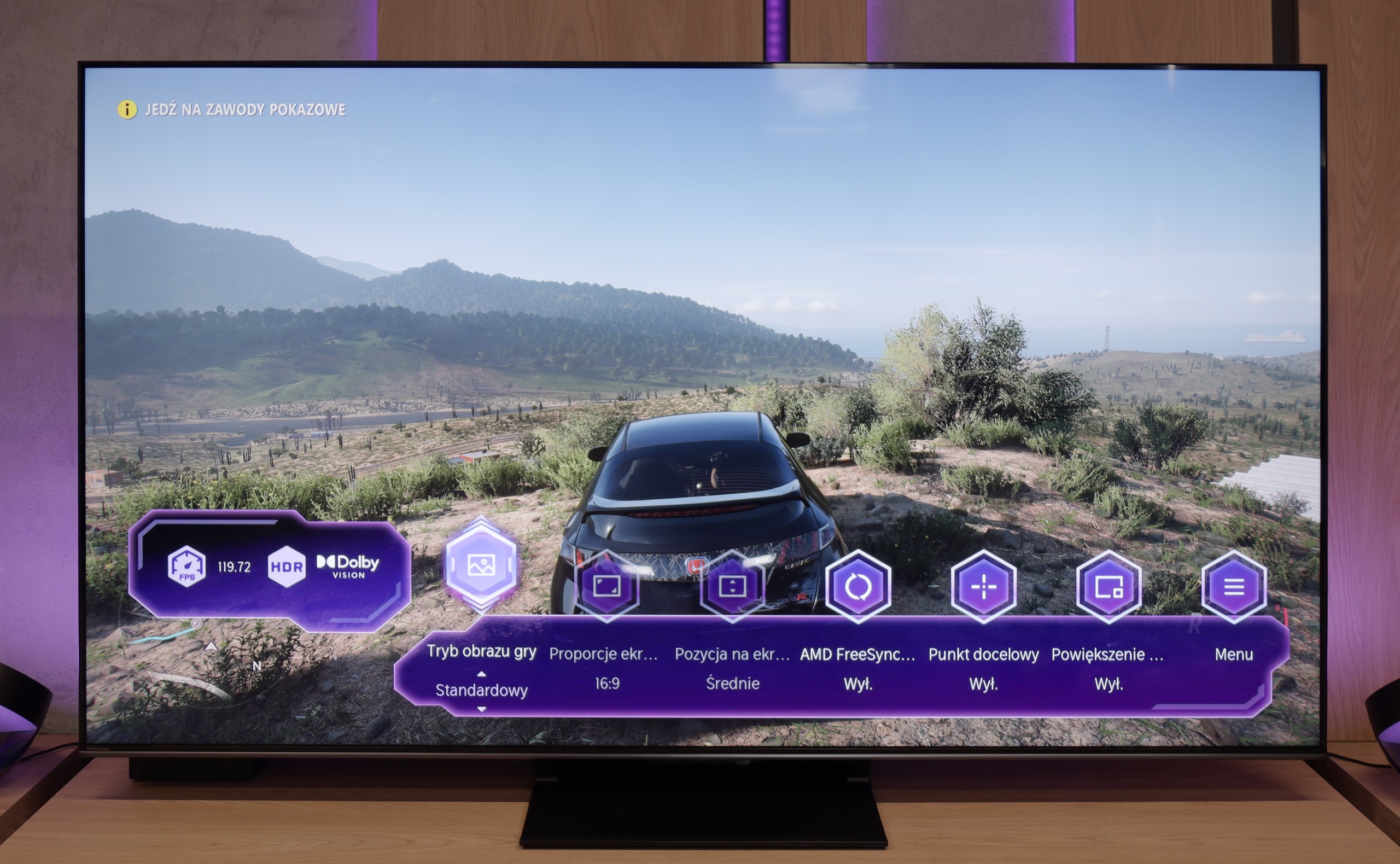

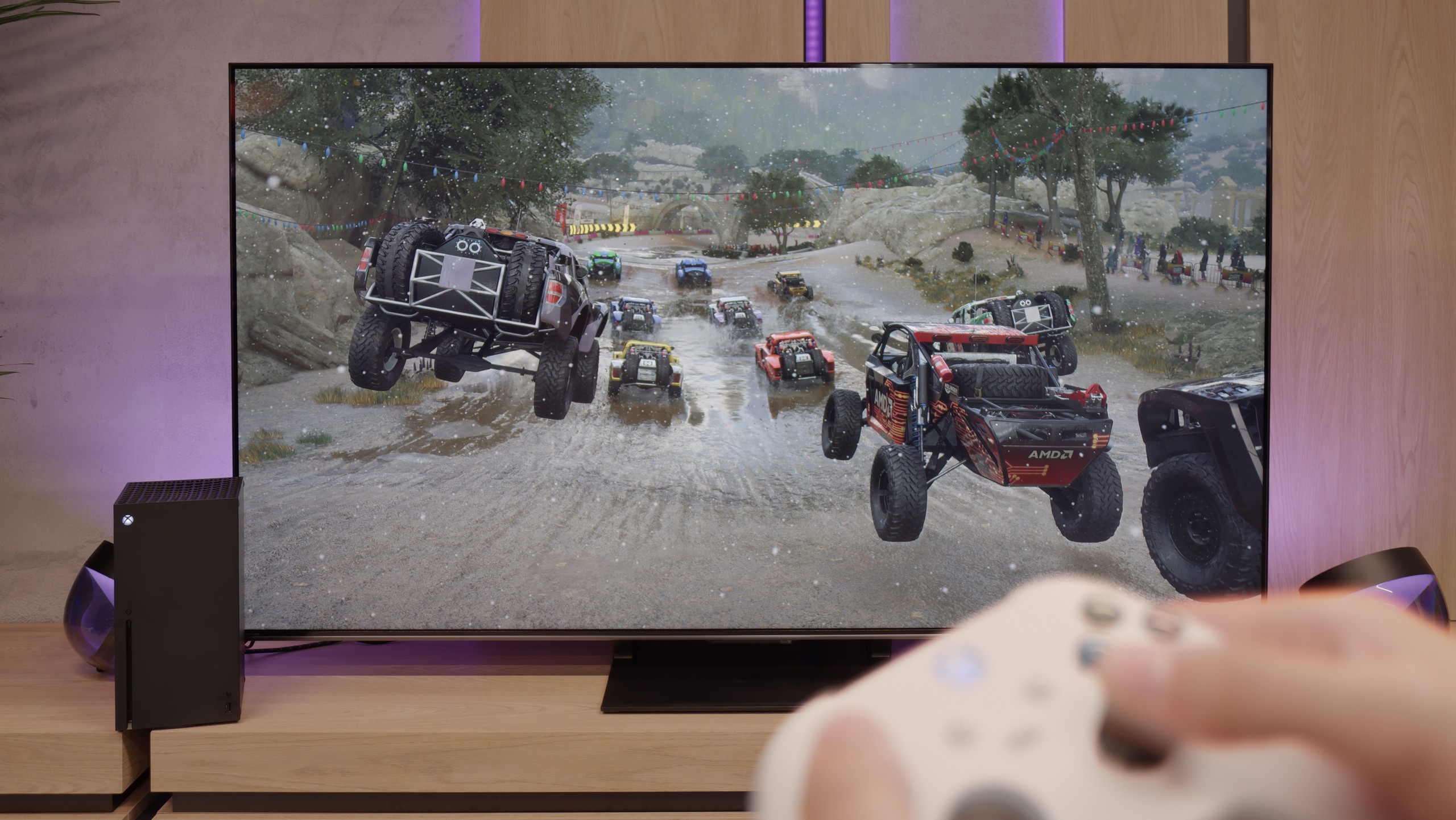
Hisense U8NQ offers everything a gamer may need for comfortable gameplay. The television supports a refresh rate of 144 Hz, ensuring an extremely smooth image, particularly in dynamic action games. The VRR (Variable Refresh Rate) feature allows the image to adjust to varying frames per second, eliminating stuttering and tearing, resulting in exceptionally fluid gameplay. Additionally, the television is equipped with an ALLM (Automatic Low Latency Mode) feature, which automatically switches the television to gaming mode, minimising input lag. This allows players to enjoy responsive gameplay without the need to manually adjust settings.
Hisense U8NQ also supports Dolby Vision, which is important for gamers who value high image quality, high contrast, and deep colours in games that support this format. The television also has a “Game Bar” — a feature that provides quick access to key settings during gameplay, significantly enhancing user convenience.
However, it is worth noting that despite its rich set of features, the Hisense U8NQ does not offer support for the HGiG standard, which is a popular HDR format in games. This may be disappointing for gamers expecting optimal detail reproduction in HDR scenes. Nevertheless, the other features of the television make the Hisense U8NQ a solid choice for console gaming enthusiasts, offering fluidity, high contrast, and user convenience.
The Hisense U7Q PRO is a television that seems almost designed with gamers in mind. It has practically everything one could expect from a gaming display: variable refresh rate (VRR), automatic low latency mode (ALLM), and as many as four HDMI 2.1b ports with full bandwidth of 48 Gb/s. Additionally, there is a clear and quite functional Game Bar, as well as a well-implemented Dolby Vision GAMING mode that works seamlessly with Xbox Series S and X consoles.
Sounds like perfection? Well, almost. Unfortunately, Hisense has still not implemented the HGiG feature, which means the system limitation of tone mapping on the television side. This means that when configuring HDR brightness on the console, we do it "by eye" or search for settings in online guides, as the display does not show the actual range of its brightness. It’s a pity – because HGiG indeed makes it easier to match the console to the television and helps avoid overexposure or overly dark scenes in HDR games.
Fortunately, the other features work very well. Input lag is low, responsiveness is excellent, and the handling of other functions is impeccable. And while not everything worked perfectly, the U7Q PRO can still be recommended to gamers without hesitation.
Input lag
9.8/10
9.8/10
SDR
HDR
Dolby Vision
The input lag on the Hisense U8NQ is at an outstanding level, maximally reaching 18 ms, which is an excellent result even in Dolby Vision mode (16ms). This achievement is worth highlighting, as Dolby Vision mode often increases delays in other television models, but here it has been managed to be avoided. Thanks to the low input lag, gameplay is smooth and responsive, which will be appreciated by both casual gamers and more advanced users.
In terms of signal latency, the Hisense U7Q PRO performs really well. For 120 Hz content, the input lag remains below 10 ms, which translates to a lightning-fast response – the screen almost instantly reacts to our movements, something console and PC gamers will particularly appreciate. With 60 Hz content, the situation is somewhat worse, as the response time doubles – this is natural and applies to virtually all televisions. Nevertheless, it still remains below 20 ms, which can be confidently considered a very good result, even close to perfection – and in practice, it is hardly noticeable during gaming.
Compatibility with PC
8/10
8.2/10

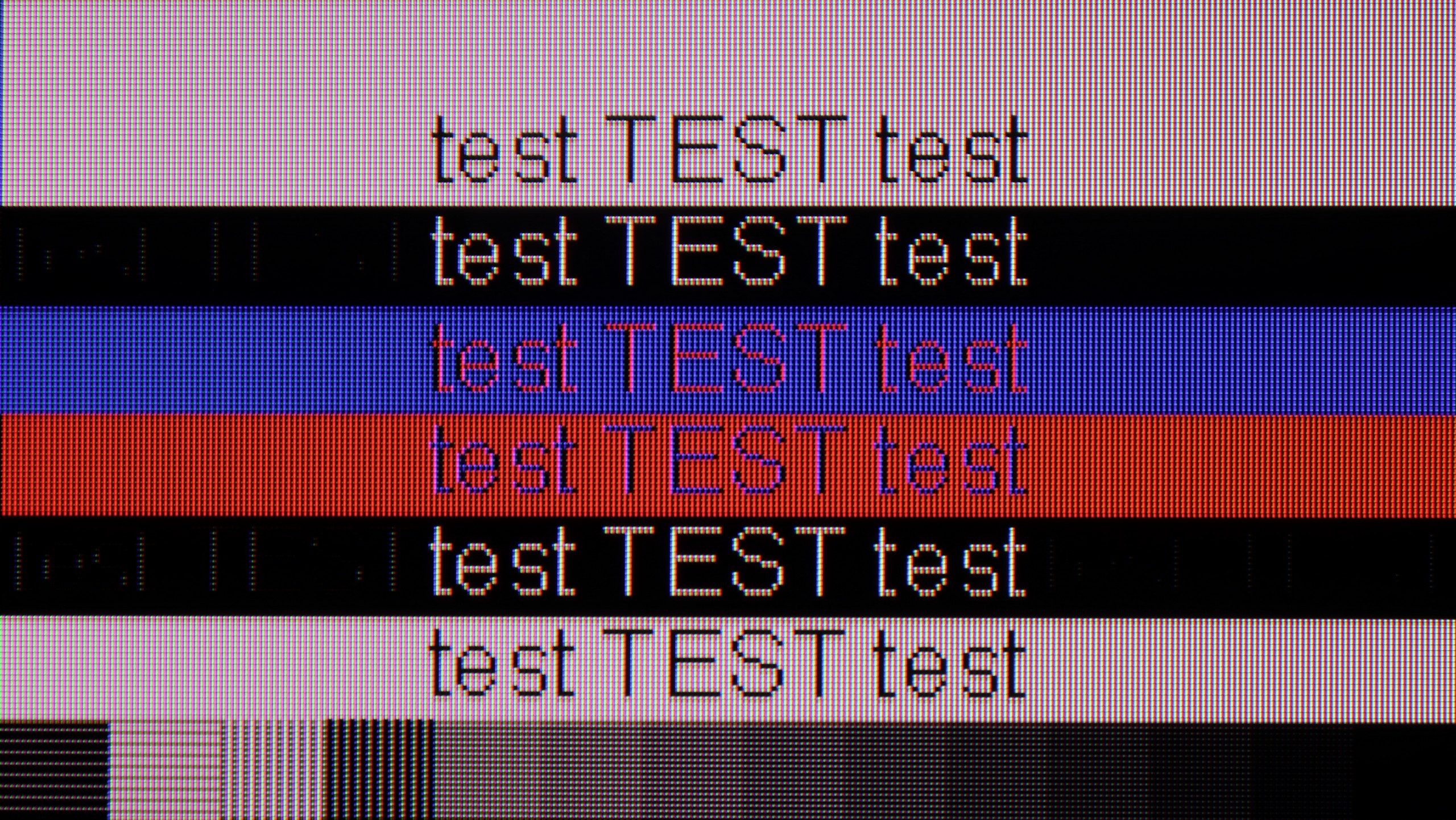
Hisense U8NQ offers full support for chroma 4:4:4, which ensures good readability of fonts, especially when working with text. Overall, the image quality and visibility of letters are at a satisfactory level. However, it is worth noting the issue related to font display on a dark background (similar to the U7N model) — in this situation, the letters become practically invisible, and only the vertical subpixels are visible.
Playing on PC using the Hisense U7Q PRO is pure fun. Low input lag, full 165 Hz in 4K and even 288 Hz in Full HD - these are numbers we wouldn’t expect from a television at this price. In this regard, it’s really hard to fault anything. If someone is looking for a large screen for gaming from a PC - the U7Q PRO can confidently serve as a monitor. It performs slightly worse for everyday work with text. Although chroma 4:4:4 is present, so theoretically everything should look good. But in practice, grey fonts on a dark background look strange – vertical lines are sharp, but horizontal ones can blur, disappear, or appear slightly dimmed. However, it must be honestly added that if you use the television as usual – that is, from a few metres away – you probably won’t notice this. The problem only becomes visible when someone places the U7Q PRO on a desk, a metre from their face, and starts working with text or spreadsheets. If you plan to use it in that way – it’s worth keeping this in mind.
Viewing angles
3.1/10
3/10
The viewing angles of the Hisense U8NQ are typical for a VA panel. Unfortunately, they leave much to be desired. The television does not have a coating that widens the viewing angles, resulting in a significant drop in image quality when viewed at an angle. Colours become washed out, and brightness noticeably decreases. It is best suited for viewing directly in front. This is a limitation that must be taken into account, especially if we plan to watch television with a larger group, where viewers may be sitting at different angles.
In this regard, the U7Q PRO performs moderately. The television is equipped with a VA panel, which inherently is not known for wide viewing angles. When we start looking at the screen at an angle, the image noticeably loses brightness, and the colours begin to wash out. This is a completely normal phenomenon in VA panels without additional coatings that widen the angles – so if you plan to watch from the side or in a larger group, it’s worth keeping this in mind. On the other hand, directly in front – the image looks great, with deep blacks and very good contrast, much better than on IPS/ADS type panels.
TV efficiency during daytime
8.7/10
6.2/10




Matrix brightness
Average luminance SDR
Hisense U7Q PRO: 472 cd/m2
Hisense U8NQ: 1236 cd/m2
Hisense U8NQ is equipped with a glossy panel that moderately suppresses reflections. Despite this, the brightness level of 1200 cd/m² is impressive and ensures that the television performs very well even in bright rooms. Thanks to such high brightness, watching content during the day is not a problem, and the picture remains sharp and readable even with a large amount of external light.
As we mentioned earlier – the U7Q PRO is really a bright television, especially when it comes to HDR content. For SDR material, the television dims a bit, but an average brightness of around 500 nits is still a very solid result. This means that it's easy to watch television or movies even in quite a bright room. Only in very extreme lighting conditions – for example, strong sunlight directly on the screen – can visibility be somewhat affected. Fortunately, Hisense has applied a satin anti-reflective coating that effectively suppresses reflections, and the blacks retain their depth even during the day. This makes a difference and allows for comfortable use of the television in various lighting conditions.
Details about the matrix
Subpixel Structure:

Panel uniformity:

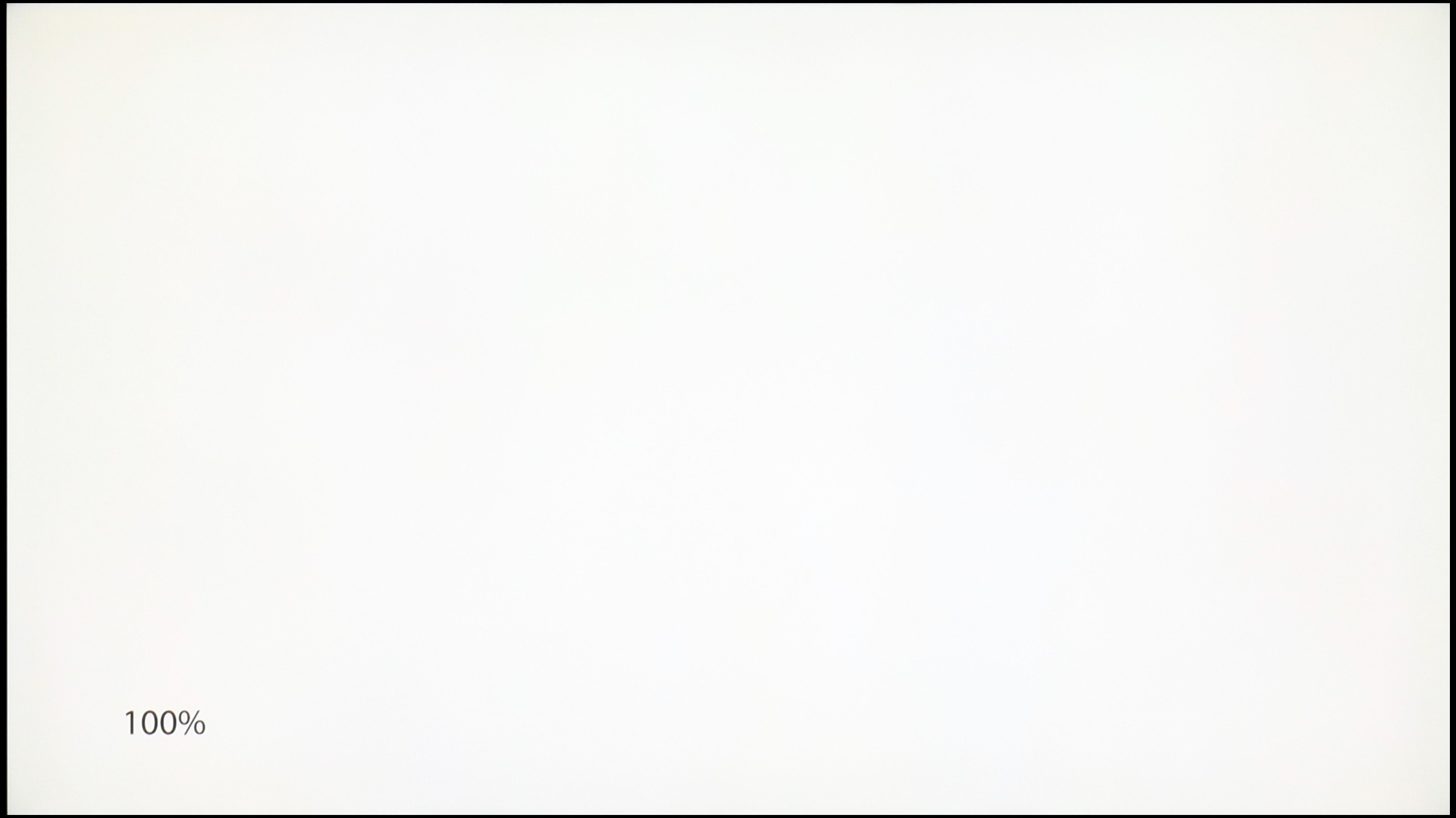
Hisense U8NQ
Hisense U7Q PRO
TV features
8.5/10
9.4/10
- HDMI inputs2 x HDMI 2.0, 2 x HDMI 2.1 48Gbps0 x HDMI 2.0, 4 x HDMI 2.1 48Gbps
- Other inputsRCA (Chinch)RCA (Chinch)
- OutputsToslink (Optical audio), eARC (HDMI), ARC (HDMI), Mini-Jack (Headphones)Toslink (Optical audio), eARC (HDMI), ARC (HDMI), Mini-Jack (Headphones)
- Network InterfacesWi-Fi 2.4GHz, Wi-Fi 5GHz, Ethernet (LAN) 100MbpsWi-Fi 2.4GHz, Wi-Fi 5GHz, Ethernet (LAN) 100Mbps
- TV receptionDVB-T, DVB-T2, DVB-S, DVB-S2, DVB-CDVB-T, DVB-T2, DVB-S, DVB-S2, DVB-C
Classic features:
- Recording to USB (terrestrial TV)
- Recording programming
- Picture in Picture (PiP)
- RF remote control (no need to aim at the screen)
- Backlit remote control
- Teletext
- Audio only mode
- Possibility to connect Bluetooth headphones to the TV
- Possibility to simultaneously use Bluetooth headphones and the TV speaker
Smart features:
- AirPlay
- Screen mirroring (Windows Miracast)
- Wyszukiwanie głosowe
- Voice search in native language
- Ability to connect a keyboard and mouse


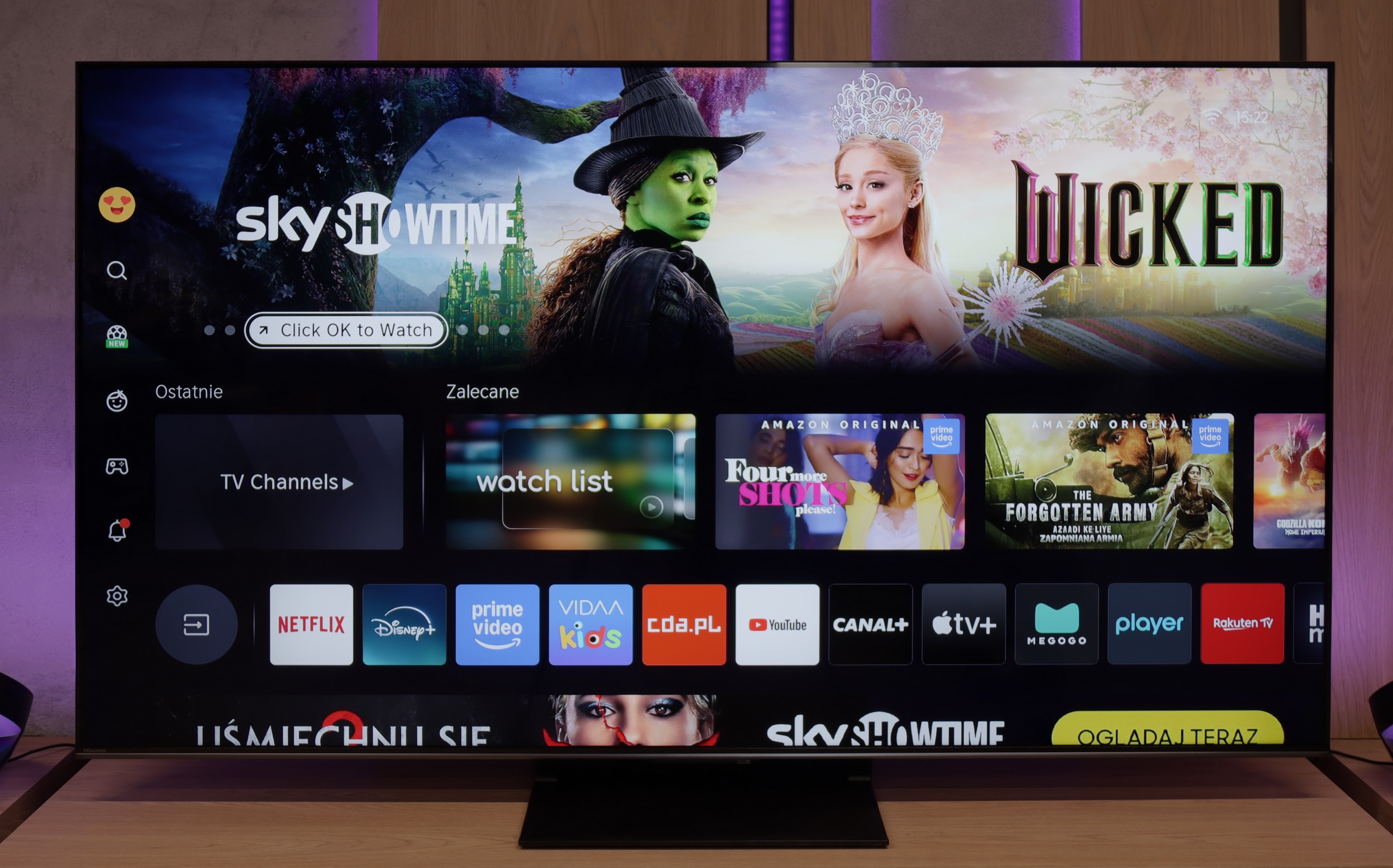
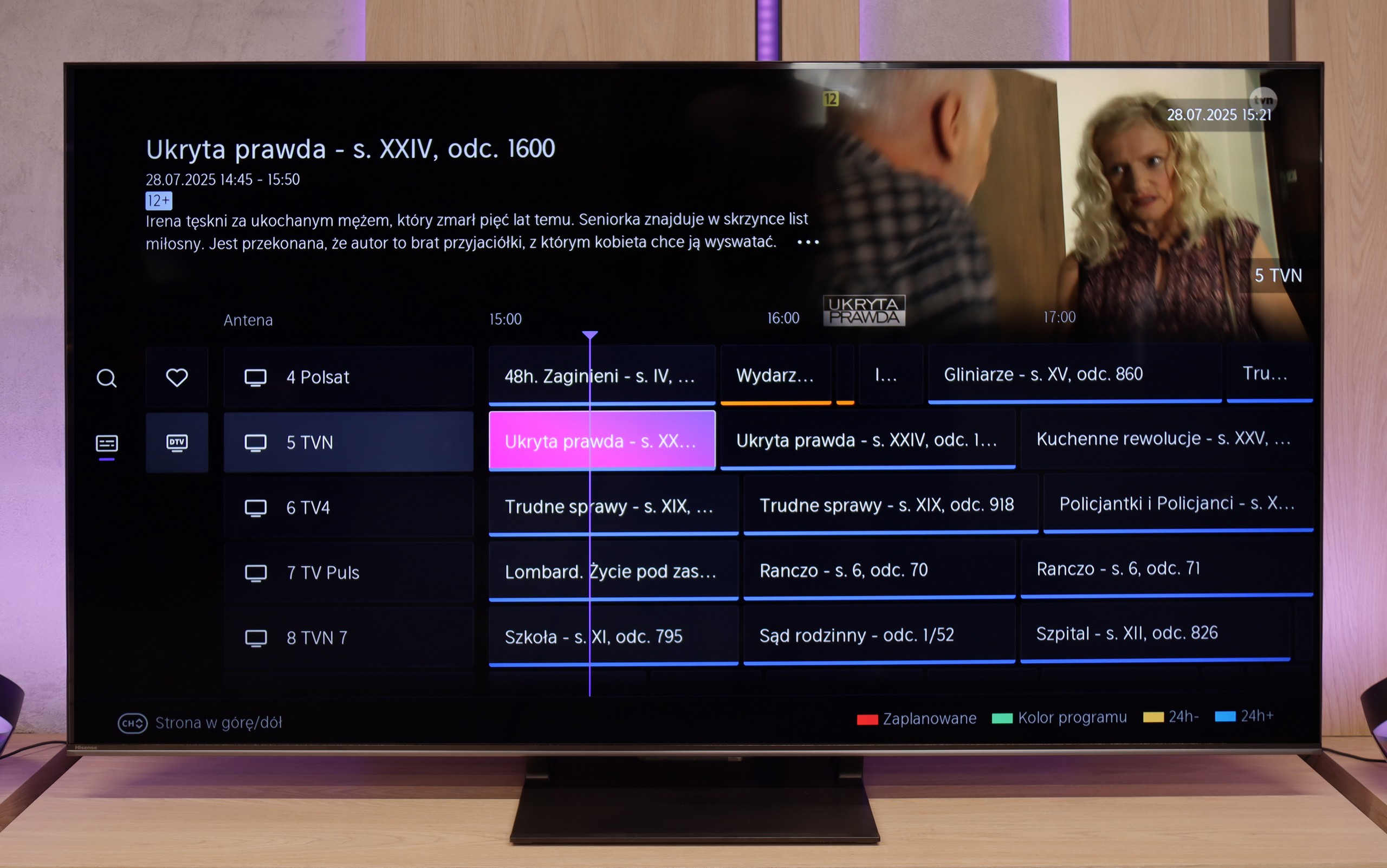
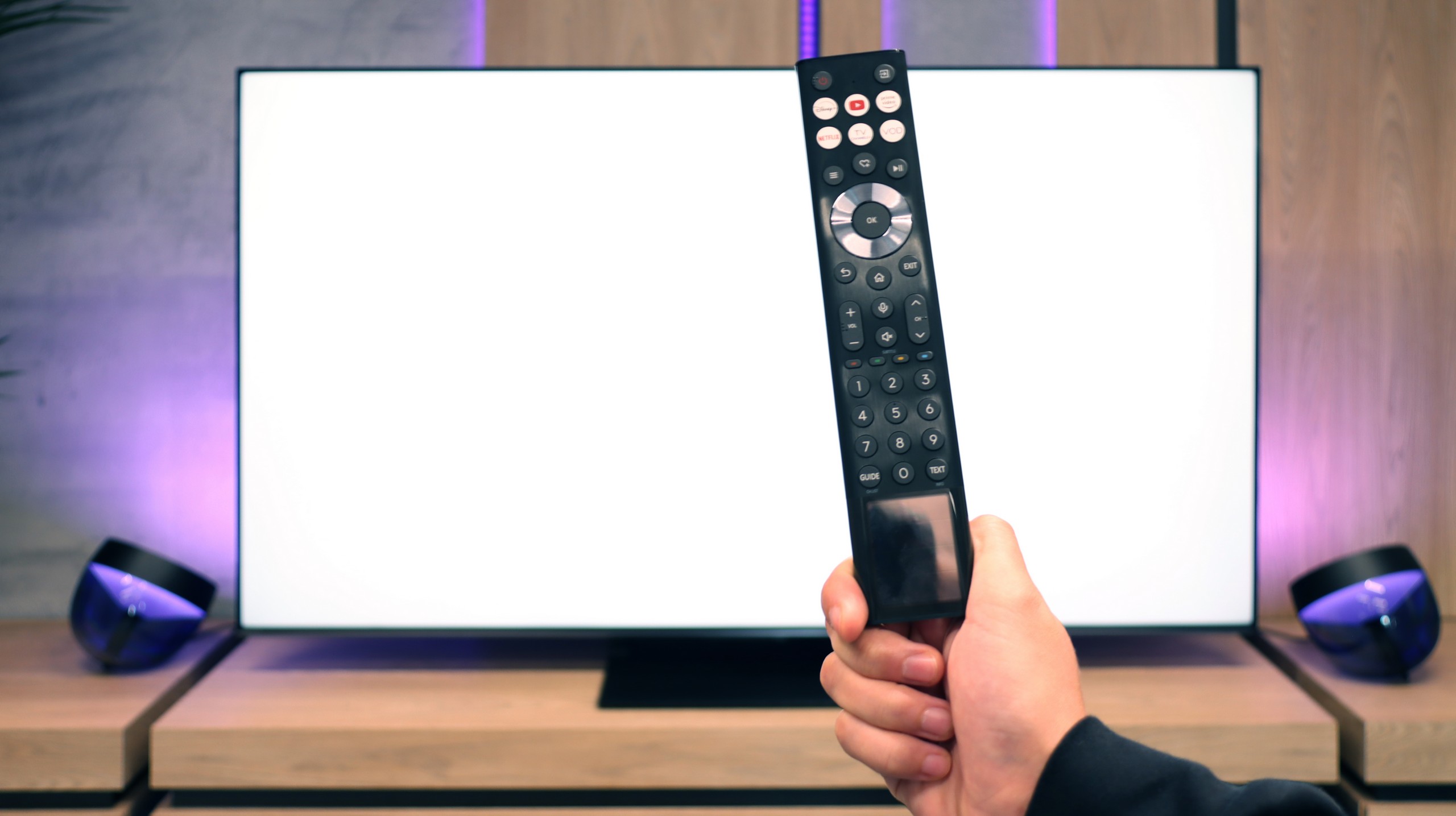

Hisense U8NQ offers many practical features. The television supports the ability to record programmes, allowing you to save your favourite content and play it back at a convenient time. Additionally, there is support for AirPlay, which enables easy streaming of media from Apple devices directly to the television screen. The Bluetooth function allows for connecting various peripheral devices, such as headphones or speakers, which further enhances user comfort. Hisense U8NQ is also equipped with a simple yet functional voice control system, making it easy to navigate the menu and select content.
The VIDAA operating system runs fairly smoothly. There are quite a few applications available, but unfortunately, it lacks those for music, such as Spotify or Tidal. It's worth keeping this in mind to avoid being forced to purchase additional devices.
In terms of design, Hisense U8NQ presents a modern look thanks to its narrow bezels and elegant stand. Although the device is not among the sleekest on the market, its appearance is still stylish and will easily fit into most interiors. Despite the somewhat thicker casing compared to the top models from competitors, the aesthetic finish and solid construction ensure that the television looks good in the living room.
Classic Features of U7Q PRO
If you plan to use the television in a more "classic" way, that is, for watching daily programs or connecting headphones, the Hisense U7Q PRO has almost everything you might expect. The television easily supports recording to USB, you can connect headphones via Bluetooth, and the remote control is backlit, which still isn't standard even in more expensive models. Although many people today forgo these classic features in favour of streaming applications, it's good to know that the U7Q PRO still does this properly and without compromises (apart from the lack of PiP functionality).
SmartTV System: Vidaa
When it comes to smart features, this model operates on the VIDAA system in Europe. The system runs smoothly, has a built-in web browser, supports voice control (also in Polish), and AirPlay, which will delight users of Apple devices. However, it's worth noting that VIDAA is a closed system, so you won't find all the popular applications that we have gotten used to with Android TV or Google TV. Before purchasing, it's advisable to check if the apps you actually use are available.
Playing files from USB
8/10
8.2/10
Supported photo formats:
Maximum photo resolution:

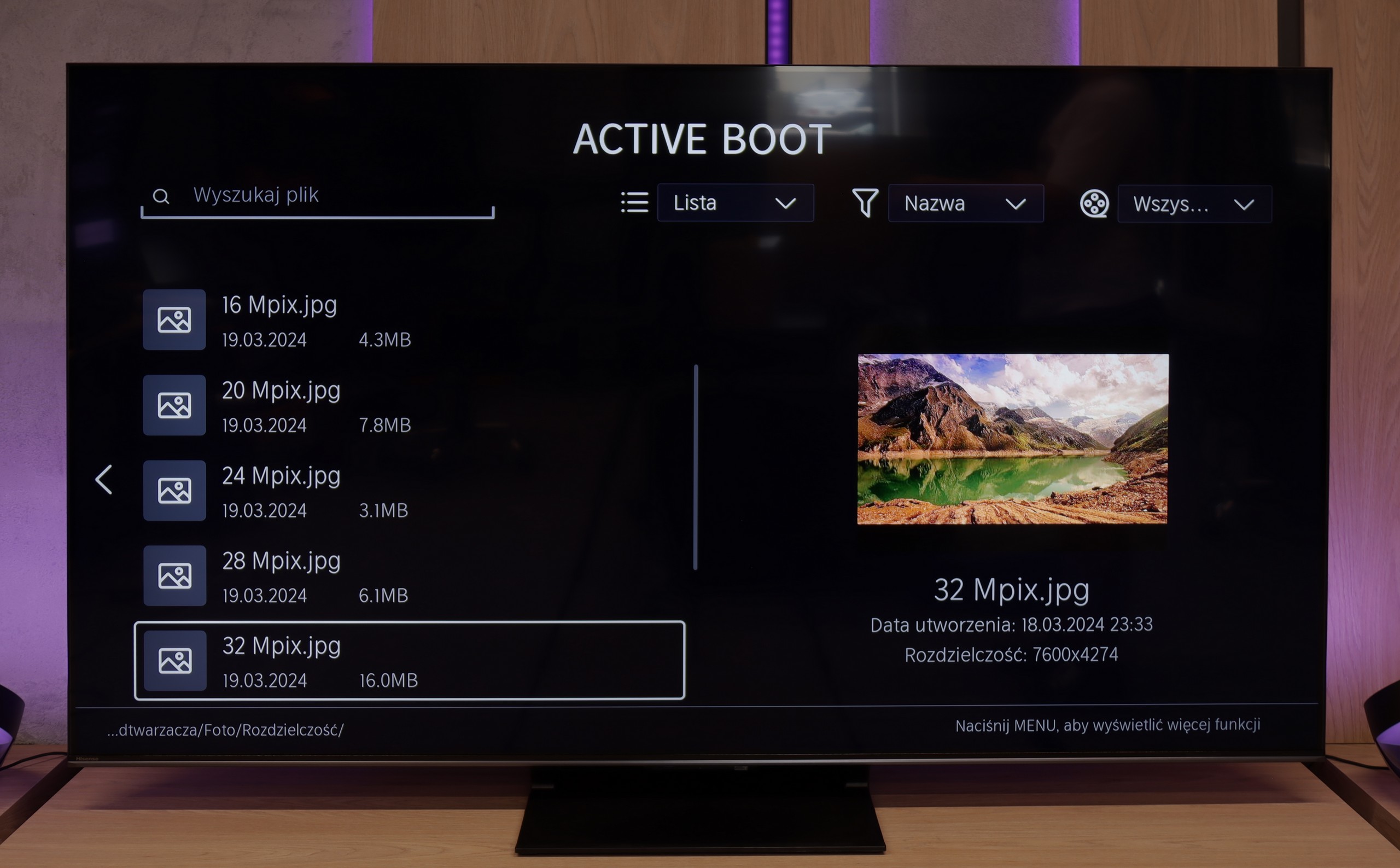
In the Hisense U8NQ, the built-in file player handles most popular video and audio formats, making it a very versatile solution for users. However, some shortcomings can be observed in less common image formats, such as Apple's HEIC. For standard formats like JPEG or MP3/4, the television works flawlessly, easily meeting the multimedia needs of most users.
The built-in media player in the VIDAA system functioned very efficiently and without issues on our U7Q PRO unit. The television effortlessly read external video and audio files, as well as subtitles, making it convenient to watch films from a USB stick or external drive. Most popular formats worked flawlessly, so there was no need to convert anything. The only drawback was a certain selectivity in handling high-resolution images – not all of them opened. Therefore, you will find a detailed list of supported photo resolutions (Mpix) in our comparison table.
Apps
7.7/10
7.7/10














































Sound
7/10
7.8/10
- Subjective sound quality:7/107.8/10
- Dolby Digital Plus 7.1:
- Dolby True HD 7.1:
- Dolby Atmos in Dolby Digital Plus (JOC):
- Dolby Atmos in Dolby True HD:
- DTS:X in DTS-HD MA:
- DTS-HD Master Audio:
Hisense U8NQ performs quite well. Both low and high tones are audible, which makes the sound full and balanced. Even at higher volume levels, the television manages without significant distortion, which is a big plus. The sound is strong enough to fill a room, which will satisfy most users who do not have an external audio system. Although the built-in speakers do not match the sound quality of home cinema systems, they are more than sufficient for everyday television viewing or movies.
Considering the standards of built-in television speakers, the U7Q PRO sounds surprisingly good. The sound is clear, with distinct mid and high tones, and the bass – although limited – doesn’t completely disappear. It can be said that for "television speakers," the level is more than satisfactory. However, it's worth noting that in our test unit we could not play sound in DTS:X format from local files – the television simply does not support it. This means that if you are counting on a cinematic spatial effect solely from its built-in speakers, there might be a certain disappointment. Fortunately, the television smoothly passes the DTS signal to an external amplifier, so if you have a home cinema – just connect it and everything works as it should.


